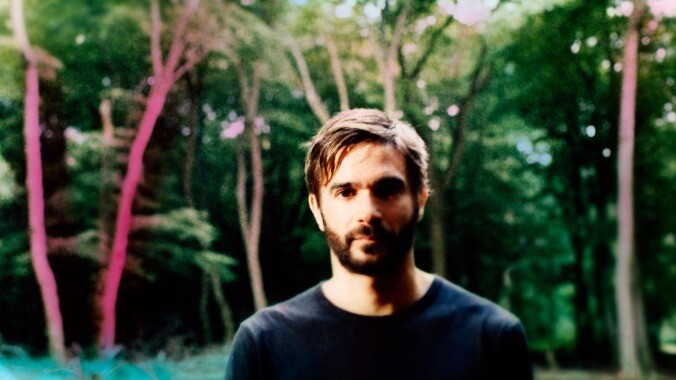It’s time to try some Music For Psychedelic Therapy, but the psychedelics are optional
Jon Hopkins’ bold, unconventional new album intersects at the place between hypnotic drone, minimalist composition, and the sounds of nature

It’s the kind of music for which the phrase “I don’t know if that’s really for me” seems tailor-made. A collection of sounds captured during field recordings in a Ecuadoran cave 200 feet below the Amazon rainforest? Droning synth runs played back through speakers hung in the woods in Devon, England? A back half of the album comprised of a single, unbroken 35-minute track that ends with spoken-word meditations from recently deceased American spiritual guru Ram Dass? It all seems impossibly fey, the kind of thing you could dismiss as pretentious horseshit—if the artist responsible weren’t Jon Hopkins.
Hopkins is one of the modern era’s most vital electronic musicians, someone whose previous albums (including The A.V. Club’s best-of-2018 list presence, Singularity) wedded lush, skittering techno with rhythmless organic beauty in increasing complex and rewarding ways. And while it seemed as though the musician would follow up his last Grammy-nominated record with something even more layered and ambitious, he’s pulled a abrupt about-face with Music For Psychedelic Therapy.
The album isn’t just a profound shift musically—you won’t find a single percussion instrument, or even faint EDM beat, lurking among the sounds herein—but also philosophically. Hopkins longed to fuse the beauty and peace he found in the natural world with the sense of artistic freedom and introspective clarity he could generate inside the confines of the studio. Hence the tracks continually moving between being played (and recorded) through speakers outdoors and his insulated studio—he started attuning his compositions to the raw sounds of nature he heard coming back to him through his headphones.
The results might be some of the most unusual, and unusually affecting, music that could easily fall under the heading of “New Age.” Despite that oft-derided term, Hopkins’ fusion of ambient, drone, and natural field recordings can’t be summarily dismissed. It’s simply too potent. At least, for this critic, it was. Rolling my eyes at the earnest and grandiloquent statements from Hopkins accompanying the press materials (“it’s a place as much as it is a sound”), I put on my headphones, pulled the shades, and prepared to hear the album in the manner Hopkins insists it is best experienced: entirely played in one sitting, lying down in the dark.
And damned if I didn’t sit up one hour later feeling more refreshed than I had in weeks, maybe months. From the spare pealing of a small bell that ushers in the opening soundwave ascension of “Welcome,” on through to the aforementioned Ram Dass segments that precede the final elegiac piano notes that close out the album, I gave myself over to the experience, even though I felt a little stupid at first. But soon, I did feel as though I’d entered the kind of trancelike state that Hopkins was striving to create in the listener.
He’s right to insist that it’s more of an experience than a record to throw on in the background, although I’ve found it to be rewarding when I’ve subsequently played it during working hours, or when I’m just doing chores around the house. But it does seem to function best as a kind of musical-spiritual deep dive—its own unique form of meditation, in a sense.
And after returning to it (and the silent, darkened room process) several times, I’ve started to realize that, underneath all the instrumentation and arrangements so unlike his previous work, Hopkins actually has constructed an edifice akin to those earlier albums. It still builds and crescendos in a manner not unlike those found on Immunity or Singularity, still seeks to provoke a kind of cathartic bliss; it’s just that he’s looking for an inner spiritual catharsis, not a physical one that could also be found packed among bodies on a dance floor.
Also, your mileage may vary, but he does recommend trying it with the titular psychedelics. Hopkins has worked closely with scientists and doctors conducting psilocybin clinical trials at Imperial College, including crafting playlists meant to aid in psychedelic therapy. (The A.V. Club, of course, would never condone the use of illegal drugs, especially not the DMT Hopkins endorses and which can often be found among certain folks on college campuses.)
But even without the mind-altering substances, Music For Psychedelic Therapy is plenty mind-altering on its own. I feel a bit like someone who spent their life turning up their nose at opera, only to accidentally stumble into the best performance of La Bohème that’s ever been put onstage. Hopkins has cleared the new-age stink off of music like this, and reinvented it for a new generation of ambient music fans looking for something not only aurally rewarding, but emotionally so.